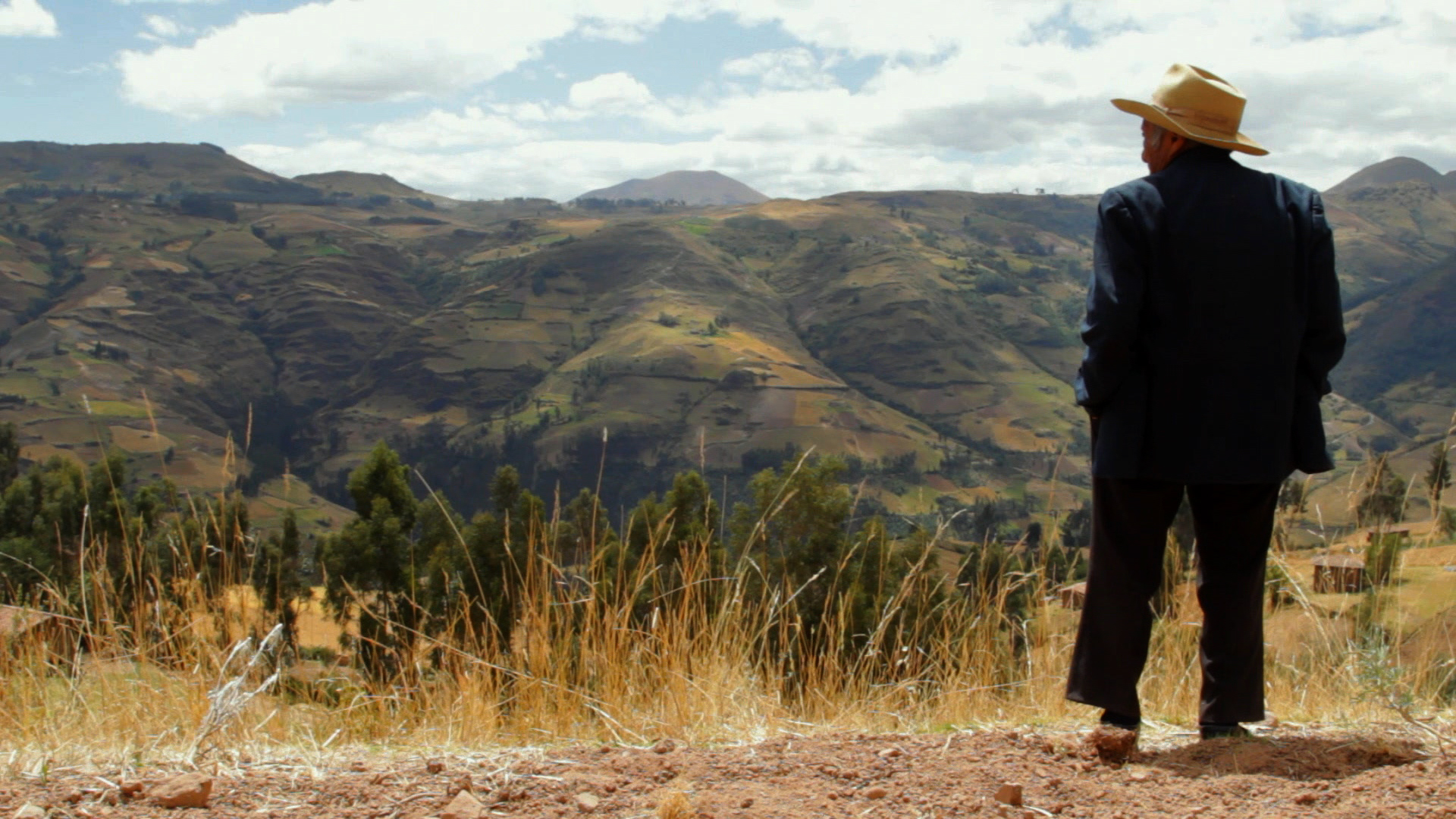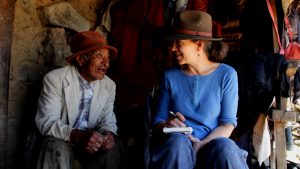
“It’s not like the past when the weather was normal … certain. At any point, you have summer. At any point, you have rain.”
So says Julio Aguilar Sandoval, a peasant farmer living in the Andes Mountains in northern Peru. Aguilar’s community, and its way of life, is withering. It’s a victim, some say, of climate change.
“Climate change disrupts life in a lot of ways,” says Dr. Kathryn Oths, professor of anthropology at The University of Alabama. “And, it disrupts the medical system.”
Oths is producing an ethnographic film on changes underway in this region. The film focuses, as Oths so often has throughout her career, on traditional medicine, healers who use herbs and techniques passed from one generation to another, rather than pharmaceuticals or formalized training.
“I’m interested in why people do what they do when they get sick and why people aren’t going into the traditional healing roles anymore,” Oths says.
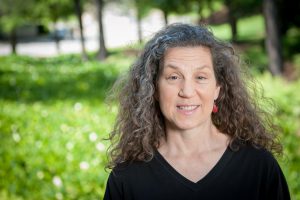
It’s an interest that pre-dates her 25-year UA career or even the first anthropology class she attended.
While taking a “stop out” year from being a human biology major at Stanford, Oths worked as a VISTA volunteer on a Navajo reservation in southeastern Utah. It was there, as a participant in the program to fight poverty in the U.S., she first became enamored with those practicing traditional medicine.
“There were very few medicine men and women,” Oths recalls. “People still wanted the services, but nobody wanted to do it.”
That spark, ignited on the reservation in 1980, developed into a sustained passion that has driven Oths for more than three decades and inspired a research career primarily focused on Latin America.
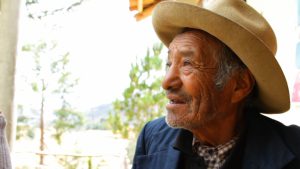
Like the best story-tellers, Oths and the film’s co-producer, Adam Booher, focus on a single face. It’s a leathery one, wrinkled by time and chapped by sun and wind. It belongs to Don Felipe Llaro, an 80-year old bonesetter, herbalist and lifetime resident of Chugurpampa, Peru.
And, according to Oths, he’s the area’s only remaining traditional medical practitioner.
“The future of an ancient medical tradition is in peril,” Booher writes on his website that hosts an early cut of the film.
A cinematographer and media production specialist with Digital Development Communications-International in Raleigh-Durham, North Carolina, Booher shot more than 24 hours of footage for the ethnography.
Oths first met Felipe in 1988 while in Peru conducting research for her dissertation she would complete at Case Western Reserve University.
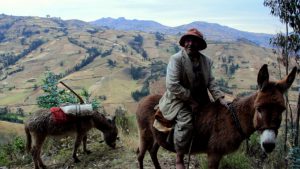
At the time, Chugurpampa, which encompasses about 1,000 acres and, until last year, featured no homes with electricity, was filled with midwives, herbalists, shamans, soul callers, general practitioners and bonesetters, Oths recalls.
“And nowadays, there is one guy, practically. Don Felipe, and he’s about the only person left. You’ve got to wonder what is happening.”
Part of what is happening is the climate-induced flight from the highlands to the coast.
“People there are agriculturalists,” Oths says. “They are farmers first. They are healers, second. People don’t get sick with so much frequency that you can see patients from nine to five. You do it when someone needs care.”
Anyone who has looked to the soil for their livelihood, or been close to someone who does, knows few things cause farmers as much consternation as the weather. Often unpredictable on a daily basis, even the generalized patterns Peruvian farmers grew to count on have been turned askew in recent years.
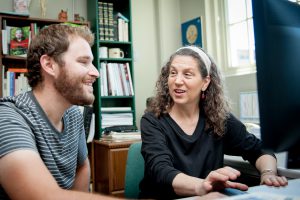
“It rains when it shouldn’t,” Oths says. “It snows when it shouldn’t, and it doesn’t rain when it should. They have a terrible time making a living. There has been a mass exodus out of the hamlet.”
Oths says she’s witnessed other oddities between her first and recent stints in the highlands.
“They have deer now, and there used not to be deer. The climate is changing radically, the fauna, the flora. Not only do they have droughts and hailstorms, but they have bug damage. They have pest damage.”
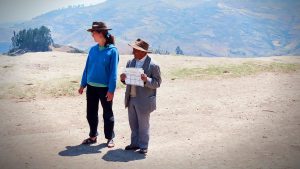
Pesticides and chemical fertilizers used in recent decades seem to have taken a toll on the soil. Over use of these chemicals seem to have robbed the soil, addicting it to more chemicals.
“They say, ‘we can’t not use them now.’ The soil just won’t produce anything otherwise.”
In one aspect of her research in the 1980s, Oths surveyed nearly 1,000 people in Chugurpampa. Upon her 2010 return, she began following up on those same families.
“About a third of the people, or even more, have permanently migrated to the coast and abandoned their lands. They are trying to make a go of it in the city.”
Others press on in place, while still others seem to have adopted a semi-nomadic lifestyle.
“Some families will split. Whole families will migrate for years at a time.”
Sometimes they return, as life along the coast isn’t easy either, and skill sets don’t always match needs.
“They are trying to use every strategy they possibly can to survive.”
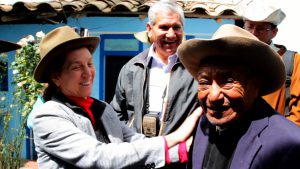
The transient lifestyle is not conducive to learning any trade, Oths says, including healing. But the shift does not seem driven by the embracement of modern medicine.
“They still have the same set of beliefs,” Oths says. “There is very little that has changed, but what has changed is the availability of the healers. The people still want them. There is a little more biomedicine available now, but not much more.”
And as sad as a fading lifestyle may be, the problems facing Peruvians are grander than the impact on one village or even the extinction of a valuable skill set, the UA researcher says.
“It is the bread basket for the country,” Oths says of Chugurpampa. “That one little hamlet sends truck after truck of potatoes out. They grow a lot of stuff that the rest of the country depends on.”
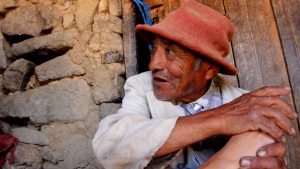
Potatoes, barley, corn, lima beans, lentil beans and other foods are produced by an increasingly diminishing number of farmers.
Oths is not satisfied with only documenting the changes. She’d prefer to turn the tide. Since she can’t change the weather patterns, she’s trying to show the area’s young people there is still something to be gained for themselves and their communities by learning to become a healer.
She seeks to re-establish Felipe as the poster child for healers.
“He was known from one end of the mountains to the other. They would call for him from villages a long distance away.
“As he got older and less mobile, his reputation had kind of receded. He’s not so able any more, either, to get out and go see people. Once, he could go do house calls, even if it took him four hours to get there. And now, he just doesn’t have the stamina for that.”
Appearing to be a combination of chiropractor, orthopedist and medicine man, Felipe prefers the term bonesetter. In the late 1990s, his fame spread locally after a man with a compound fracture traveled to a hospital in Julcan, about a two-hour walk from Chugurpampa.
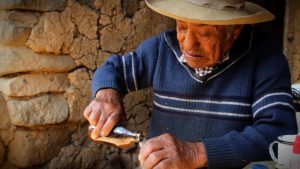
Doctors there turned away the patient, saying the break was too compound to repair, Oths says. The man went to Felipe who set his leg, using a gentle casting method he developed. Felipe was using flexible, removable casts long before they became acceptable treatment methods in the U.S., Oths said.
The man later returned to the hospital to show off Felipe’s work. The doctors were amazed, and x-rays confirmed what they almost couldn’t believe.
“He got this fame among the doctors,” Oths said. “They understood him to have resources that they didn’t have.”
As for Felipe, he credits God as his resource. He tells Oths of visions from God, directing him to go to certain fields and pick certain herbs to be used in treatment.
Oths points out that Felipe’s grandmother was also a healer, and he spent time with her watching and learning.
After seeing how Felipe’s reputation had slowly slipped outside his community – though not within it – and noting the lack of interest from young people to learn his ways, Oths organized a two-day conference at the Julcan hospital to bolster Felipe.
In the weeks leading up to it, she, with the hospital’s help, prompted an area radio station to make periodic announcements inviting residents to attend and receive free treatments from Felipe. Various Peruvian academics and medical personnel, as well as other healers, were also invited to observe and learn.
“Peasant people from surrounding villages came in and got treatment. Some of them would say, ‘I fell off my donkey, and I have this back pain.’
“He did some amazing stuff, because he’s amazing. He just is. He has unique techniques … how he moves people and does adjustments.”
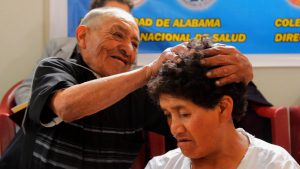
And the 2013 conference, Oths says, seems to have helped mend the broken spirit of the healer himself, whose wife died three months prior, and whose talented hands were no longer in as high a demand.
“It inspired him again and gave him a new sense of confidence,” Oths says. “You can see that from the beginning of the film to the end. He’s had more clients.
“We were hoping,” Oths says, “to find an apprentice.”
And, as the forthcoming movie will document, his granddaughter – perhaps because of all the attention or, perhaps, because it was just time – announced her interest in following in his footsteps.
“She’s young, but she wants to do it. She’s living with her grandpa, and she’s learning what she can from him while he’s still here.
Oths says it’s difficult for Felipe to describe his treatment methods on camera. He had no difficulty showing her, though, if a patient was present.
“His hands know,” Oths says.
Oths used the power of the Internet, in the form of crowd-source funding, to raise money to purchase film equipment for Booher and to pay for his airfare. A 2012 UA New College graduate who took campus courses in both anthropology and telecommunication and film, Booher transitioned from being Oth’s former pupil to her project colleague.
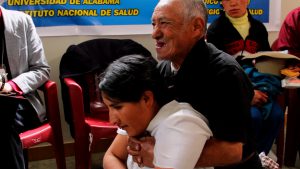
She’s repaying larger contributors by sharing with them a 21-minute version of the film. A UA Research Grants Committee award also helped with funding.
Oths later hopes to land an agreement with a distributor to market a longer version of the film for educational purposes.
“My point is not to make any money off it,” Oths said. “But, any money we do make goes to Don Felipe and his granddaughter.”
The upcoming film is titled “The Last Bonesetter.”
Oths hopes the young villagers will find a way to stay in their community and embrace the possibilities of subsidizing their meager means through the tradition-rich trade that helps heal their families and neighbors.
Felipe tells Oths and Booher, while the camera rolls, that he will not be leaving as so many others have. Oh, he visits his children on the coast on occasion, but he’ll always return, he says.
“This is where I live,” he says in Spanish, while subtitles appear across his chest. “I will die here. Here, they will bury me.”
